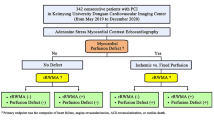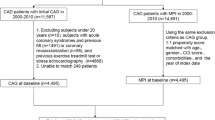Abstract
Background
We evaluated the prognostic value of changes in perfusion defect size (PDS) on serial MPS in patients treated with primary percutaneous coronary intervention (PCI) after acute myocardial infarction (AMI).
Methods
We enrolled 112 patients treated with primary PCI after AMI who underwent two stress MPS within 1 month and after 6 months. Improvement in PDS was defined as a reduction ≥5%. Remodeling was defined as an increase in left ventricular (LV) end-diastolic volume index ≥20%. Cardiac events included cardiac death, nonfatal MI, unstable angina, repeated revascularization, and heart failure.
Results
During a median follow-up of 86 months, 22 events occurred. Event rate was higher (P < .01) in patients with worsening of PDS compared to those with unchanged or improved PDS. Moreover, patients with remodeling had a higher (P < .001) event rate compared to those without. At Cox analysis, worsening of PDS and remodeling resulted independent predictors of events (both P < .01). Patients with both worsening of PDS and remodeling had the worst event-free survival (P <.001).
Conclusion
In patients treated with primary PCI after AMI, worsening of PDS and remodeling are associated to higher risk of events at long-term follow-up. Gated stress MPS improves risk stratification in these patients.






Similar content being viewed by others
Abbreviations
- AMI:
-
Acute myocardial infarction
- PCI:
-
Percutaneous coronary intervention
- MPS:
-
Single-photon emission computed tomography myocardial perfusion imaging
- LV:
-
Left ventricular
- PDS:
-
Perfusion defect size
- EDV:
-
End-diastolic volume
- ESV:
-
End-systolic volume
- EF:
-
Ejection fraction
- AER:
-
Annual event rate
References
Ibanez B, James S, Agewall S, Antunes MJ, Bucciarelli-Ducci C, Bueno H, ESC Scientific Document Group, et al (2018) 2017 ESC Guidelines for the management of acute myocardial infarction in patients presenting with ST-segment elevation: The Task Force for the management of acute myocardial infarction in patients presenting with ST-segment elevation of the European Society of Cardiology (ESC). Eur Heart J 39:119–177
Zhao Z-Q, Nakamura M, Wang N-P (2000) Reperfusion induces myocardial apoptotic cell death. Cardiovasc Res 45:651–660
Bolognese L, Neskovic AN, Parodi G, Cerisano G, Buonamici P, Santoro GM et al (2002) Left ventricular remodeling after primary coronary angioplasty. Patterns of left ventricular dilation and long-term prognostic implications. Circulation 106:2351–2357
Gibbons RJ, Miller TD, Christian TF (2000) Infarct size measured by single photon emission computed tomographic imaging with (99m)Tc-sestamibi: a measure of the efficacy of therapy in acute myocardial infarction. Circulation 101:101–108
Petretta M, Acampa W, Daniele S, Zampella E, Assante R, Nappi C et al (2016) Long-term survival benefit of coronary revascularization in patients undergoing stress myocardial perfusion imaging. Circ J 80:485–493
Iskandrian AE, Hage FG, Shaw LJ, Mahmarian JJ, Berman DS (2014) Serial myocardial perfusion imaging: defining a significant change and targeting management decisions. JACC Cardiovasc Imaging 7:79–96
Romero-Farina G, Aguadé-Bruix S, Candell-Riera J, Pizzi MN, Pineda V, Figueras J et al (2013) Acute myocardial infarction: estimation of at-risk and salvaged myocardium at myocardial perfusion SPECT 1 month after infarction. Radiology 269:577–584
Calabretta R, Castello A, Linguanti F, Tutino F, Ciaccio A, Giglioli C et al (2018) Prediction of functional recovery after primary PCI using the estimate of myocardial salvage in gated SPECT early after acute myocardial infarction. Eur J Nucl Med Mol Imaging 45:530–537
Berti V, Sciagrà R, Acampa W, Ricci F, Cerisano G, Gallicchio R et al (2011) Relationship between infarct size and severity measured by gated SPECT and long-term left ventricular remodelling after acute myocardial infarction. Eur J Nucl Med Mol Imaging 38:1124–1131
Smit JM, Hermans MP, Dimitriu-Leen AC, van Rosendael AR, Dibbets-Schneider P, de Geus-Oei LF et al (2018) Long-term prognostic value of single-photon emission computed tomography myocardial perfusion imaging after primary PCI for STEMI. Eur Heart J Cardiovasc Imaging 19:1287–1293
Antman EM, Anbe DT, Armstrong PW, Bates ER, Green LA, Hand M et al (2004) ACC/AHA guidelines for the management of patients with ST-elevation myocardial infarction; a report of the American College of Cardiology/American Heart Association Task Force on Practice Guidelines (Committee to Revise the 1999 Guidelines for the Management of patients with acute myocardial infarction). J Am Coll Cardiol 44:E1-211
Verberne HJ, Acampa W, Anagnostopoulos C, Ballinger J, Bengel F, De Bondt P et al (2015) EANM procedural guidelines for radionuclide myocardial perfusion imaging with SPECT and SPECT/CT: 2015 revision. Eur J Nucl Med Mol Imaging 42:1929–1940
Germano G, Kiat H, Kavanagh PB, Moriel M, Mazzanti M, Su HT et al (1995) Automatic quantification of ejection fraction from gated myocardial perfusion SPECT. J Nucl Med 36:2138–2147
Berman DS, Abidov A, Kang X, Hayes SW, Friedman JD, Sciammarella MG et al (2004) Prognostic validation of a 17-segment score derived from a 20-segment score for myocardial perfusion SPECT interpretation. J Nucl Cardiol 11:414–423
Slomka PJ, Nishina H, Berman DS, Akincioglu C, Abidov A, Friedman JD et al (2005) Automated quantification of myocardial perfusion SPECT using simplified normal limits. J Nucl Cardiol 12:66–77
Otaki Y, Betancur J, Sharir T, Hu LH, Gransar H, Liang JX et al (2020) 5-Year prognostic value of quantitative versus visual MPI in subtle perfusion defects: results from REFINE SPECT. JACC Cardiovasc Imaging 13:774–785
Hicks KA, Tcheng JE, Bozkurt B, Chaitman BR, Cutlip DE, Farb A et al (2015) 2014 ACC/AHA Key data elements and definitions for cardiovascular endpoint events in clinical trials: a report of the American College of Cardiology/American Heart Association Task Force on Clinical Data Standards (Writing Committee to Develop Cardiovascular Endpoints Data Standards). J Am Coll Cardiol 28(66):403–469
Knuuti J, Wijns W, Saraste A, Capodanno D, Barbato E, Funck-Brentano C, ESC Scientific Document Group, et al (2019) ESC Guidelines for the diagnosis and management of chronic coronary syndromes. Eur Heart J 41:407–477
French BA, Kramer CM (2007) Mechanisms of post-infarct left ventricular remodeling. Drug Discov Today Dis Mech. 4:185–196
Acampa W, Evangelista L, Petretta M, Liuzzi R, Cuocolo A (2007) Usefulness of stress cardiac single-photon emission computed tomographic imaging late after percutaneous coronary intervention for assessing cardiac events and time to such events. Am J Cardiol 100:436–441
Spinelli L, Petretta M, Cuocolo A, Nicolai E, Acampa W, Vicario L et al (1999) Prediction of recovery of left ventricular dysfunction after acute myocardial infarction: comparison between 99mTc-sestamibi cardiac tomography and low-dose dobutamine echocardiography. J Nucl Med 40:1683–1692
Spinelli L, Petretta M, Acampa W, He W, Petretta A, Bonaduce D et al (2003) Prognostic value of combined assessment of regional left ventricular function and myocardial perfusion by dobutamine and rest gated SPECT in patients with uncomplicated acute myocardial infarction. J Nucl Med 44:1023–1029
Uren NG, Crake T, Lefroy DC, de Silva R, Davies GJ, Maseri A (1993) Delayed recovery of coronary resistive vessel function after coronary angioplasty. J Am Coll Cardiol 21:612–621
Lipiecki J, Cachin F, Durel N, de Tauriac O, Ponsonnaille J, Maublant J (2004) Influence of infarct-zone viability detected by rest Tc-99m sestamibi gated SPECT on left ventricular remodeling after acute myocardial infarction treated by percutaneous transluminal coronary angioplasty in the acute phase. J Nucl Cardiol 11:673–681
Stone GW, Selker HP, Thiele H, Patel MR, Udelson JE, Ohman EM et al (2016) Relationship between infarct size and outcomes following primary PCI: patient level analysis from 10 randomized trials. J Am Coll Cardiol 67:1674–1683
Dakik HA, Wendt JA, Kimball K, Pratt CM, Mahmarian JJ (2005) Prognostic value of adenosine Tl-201 myocardial perfusion imaging after acute myocardial infarction: results of a prospective clinical trial. J Nucl Cardiol 12:276–283
Bax JJ, Schinkel AF, Boersma E, Elhendy A, Rizzello V, Maat A et al (2004) Extensive left ventricular remodeling does not allow viable myocardium to improve in left ventricular ejection fraction after revascularization and is associated with worse long-term prognosis. Circulation. 110(11 Suppl 1):II18–II22
Hendel RC, Berman DS, Di Carli MF, Heidenreich PA, Henkin RE, Pellikka PA et al (2009) 2009 appropriate use criteria for cardiac radionuclide imaging: a report of the American College of Cardiology Foundation Appropriate Use Criteria Task Force, the American Society of Nuclear Cardiology, the American College of Radiology, the American Heart Association, the American Society of Echocardiography, the Society of Cardiovascular Computed Tomography, the Society for Cardiovascular Magnetic Resonance, and the Society of Nuclear Medicine. Circulation 119:e561–e587
Disclosure
Emilia Zampella, Teresa Mannarino, Valeria Gaudieri, Adriana D’Antonio, Francesco Giallauria, Roberta Assante, Valeria Cantoni, Roberta Green, Ciro Gabriele Mainolfi, Carmela Nappi, Andrea Genova, Mario Petretta, Alberto Cuocolo, and Wanda Acampa declare that they have no financial conflict of interest.
Author information
Authors and Affiliations
Corresponding author
Additional information
Publisher's Note
Springer Nature remains neutral with regard to jurisdictional claims in published maps and institutional affiliations.
Supplementary Information
Below is the link to the electronic supplementary material.
Supplementary file 3 (M4A 3502 KB)
Rights and permissions
About this article
Cite this article
Zampella, E., Mannarino, T., Gaudieri, V. et al. Effect of changes in perfusion defect size during serial stress myocardial perfusion imaging on cardiovascular outcomes in patients treated with primary percutaneous coronary intervention after myocardial infarction. J. Nucl. Cardiol. 29, 2624–2632 (2022). https://doi.org/10.1007/s12350-021-02770-z
Received:
Accepted:
Published:
Issue Date:
DOI: https://doi.org/10.1007/s12350-021-02770-z




